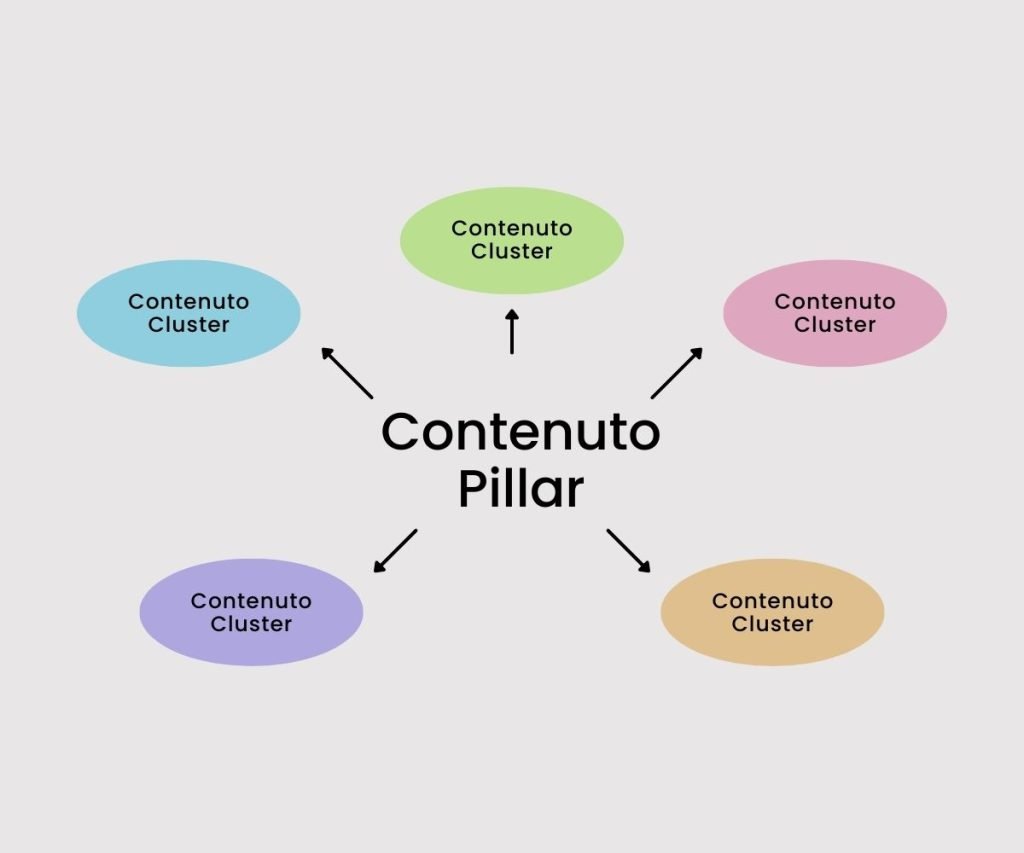Introduction
The main goal of the Pillar Page is to provide comprehensive, complete, and highly informative content on a specific topic, serving as a central reference point for the entire cluster of related content. This approach, known as the Topic Cluster Model, organizes blog content in such a way that users can find accurate and quick answers to their questions.
What is the Topic Cluster Model
The Topic Cluster Model is a content organization strategy that relies on the creation of a page used as the core of a cluster of related content.
Enjoy:
- Over 60 AI tools to create quality content
- More time for creativity, stress-free
- Impactful content that attracts readers and visitors
All with just one click.
The basic elements of the Topic Cluster Model include:
- The Pillar content
- Cluster contents
- Internal links
What is the Pillar Page or a Pillar article
The Pillar Page represents the “pillar page” of an entire content marketing strategy based on the Topic Cluster Model. It is a comprehensive content page that covers a specific topic in detail and in depth. It represents the high-level content and provides an overview of the topic covered, while related Cluster Content delves into specific aspects.

Key features of the Pillar Page include:
- Length of about 3000 words: should be extensive content covering the topic in detail.
- Thematic vertical: focuses on a main topic, providing broad coverage of all its facets.
- Internal links: is connected to related Cluster Content through internal links, creating a solid and organized structure.
Cluster Content
Cluster Content is critical to the success of a strategy based on the Topic Cluster Model. This specific content is an ideal complement to the Pillar Page, providing detailed insights into subtopics related to the main topic. The goal of Cluster Content is to meet the needs of users who want more specific and in-depth information.
When creating cluster pages, it is essential to maintain a close correlation with the main page. This is achieved through the strategic use of internal links that connect content together. Internal links allow users to easily navigate between the Pillar Page and the Cluster Content, creating a clear and logical path of in-depth information. In addition, internal links make it easier for search engines to understand the thematic relationship, contributing to better overall website ranking.
It is important that Cluster Content is relevant and up-to-date. They must provide valuable and additional information to the main page content, thus expanding the user’s knowledge of the topic covered. They may also include practical examples, case studies, detailed guides, or in-depth coverage of specific subcategories of the main topic.
To identify appropriate Cluster Content, it is advisable to conduct a thorough search for keywords related to the main topic. Use keyword analysis tools to find out what users’ most frequently asked questions and queries are. This will help you identify the most relevant subtopics to cover in Cluster Content and create highly targeted content that meets the needs of your target audience.
Internal link (hyperlink)
Internal links are hyperlinks that connect the Pillar Page to related Cluster Content. These links play a crucial role in the Topic Cluster Model structure, allowing users to easily navigate through content and search engines to understand the thematic relationship between different pages. The use of internal links also promotes the optimal distribution of link juice, or the authority and relevance of a page.
The SEO benefits of the Topic Cluster Model
Implementing the Topic Cluster Model provides numerous benefits for both users and the search engine, while also improving the architecture of the blog and the website as a whole.
Benefits for users
The structure of the Topic Cluster Model allows users to easily access basic information via the Pillar Page, providing a comprehensive view on the topic being discussed. At the same time, users can delve further into the topic through specific Cluster Content. This approach promotes intuitive navigation and a better overall user experience.
Benefits for the search engine
Internal links within the Topic Cluster Model allow search engines to understand and recognize the thematic relationship between different pages. This facilitates the indexing of pages by search engines, improving the overall ranking of the website. In addition, Cluster Content enriches the overall quality of the content and contributes to greater relevance of the subject matter.
Benefits for the website
The architecture of the blog and website becomes more organized with the implementation of the Topic Cluster Model. Creating a solid Pillar Page and connecting it with relevant Content Clusters enables optimal distribution of link juice through internal links. This means that the authority and relevance accumulated by the page can be transferred to related content, improving overall page ranking in the search engine.
How to create a perfect Pillar Page
Creating a perfect Pillar Page requires a strategic approach and attention to detail. Below are the key steps to create a successful one:
1. Topic selection.
The starting point for creating a Pillar Page is listening to users’ needs and questions. Use monitoring tools such as search engine analysis, social media, or online discussion platforms to identify the
recurring problems and frequently asked questions from users related to the topic you wish to cover. This research phase is critical to understanding the needs of your audience and creating a comprehensive solution.
2. Keyword research and beginning of writing
After selecting the main topic, it is necessary to conduct related keyword research to optimize the content for search engines. Use keyword analysis tools such as Google Keyword Planner, SEMrush or Ahrefs to identify keywords relevant to the topic. Be sure to include long-tail keywords that show good search volume and low competition.
Once you have the relevant keywords, you can start writing the Pillar Page. Structure the content into paragraphs and use headings (H2) and subheadings (H3) to optimize the text for search engines. Be sure to include main keywords in paragraph and sub-paragraph headings in a way that is natural and consistent with the context. Keep in mind that the main goal is to provide quality content that is useful and informative for users.
Example of Pillar Page
To better understand how to successfully implement a Pillar Page, let’s look at a practical example of structuring an editorial plan in the e-commerce industry. Let’s imagine we want to create one titled “A Complete Guide to E-commerce Success: Strategies, Trends and Best Practices.” This core content would provide a broad overview of e-commerce, covering topics such as setting up an online store, digital marketing strategies, and the latest industry trends.
Related Content Clusters could include topics such as “How to optimize the checkout process to increase conversions,” “Influencer marketing strategies to promote products online,” and “The importance of user experience in customer retention.” This specific content would delve into aspects related to e-commerce, providing practical tips and linking to the Pillar Page via internal links.
To further explore the proposed topic, tools such as Google Trends and SEMrush can be used to identify search trends and keywords related to e-commerce. Through keyword analysis, it is possible to identify the most frequently asked questions and queries of users in the field, thus enabling the creation of highly targeted and relevant content.
For example, the use of Google Trends might reveal that keywords such as “apparel ecommerce,” “online store marketing strategies,” and “ecommerce trends” are growing strongly. This information can guide the writing of Cluster Content, ensuring that it is relevant and meets the needs of users interested in e-commerce.
Use of images and videos in the Pillar Page
When creating a Pillar Page, do not forget the importance of including visual elements such as images and videos. These elements enrich the user experience, increase engagement, and make content more attractive and accessible.
Choose images and videos relevant to your topic. Images should be high quality and optimized for website performance, while videos should be short, engaging, and relevant. Be sure to include alt descriptions for images and alt text for videos so that they are accessible for users with disabilities or media loading problems.
Conclusions
Pillar Pages are a key element in the content marketing strategy based on the Topic Cluster Model. Creating a well-structured and informative Pillar Page can significantly improve your website page rankings on search engines and provide a better user experience for your users. Follow the key steps outlined in this article and use keyword analysis tools to create a perfect Pillar Page that is useful, informative, and relevant to your target audience.
